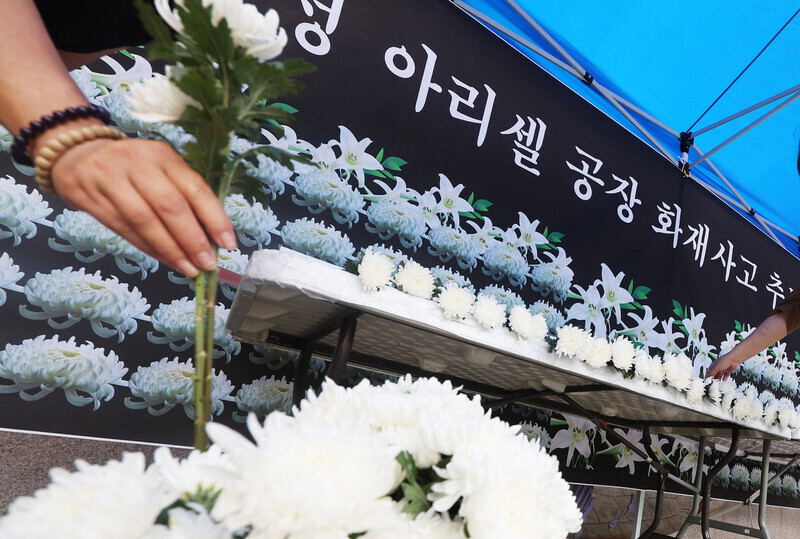hankyoreh
Links to other country sites 다른 나라 사이트 링크
[Column] How tragedy pervades weak links in Korean labor


By Hwang Bo-yon, editorial writer
Two brothers from Vietnam died on the same day in August 2023 at a construction site in Gyeonggi Province. They had been placing concrete on the ninth floor when the structure came crashing down.
The construction site used a deck plate method, without support for floor posts on the lower stories. Construction companies favor this approach as a way to save time and money, but it can be extremely dangerous if the proper sequences and safety rules are not observed.
It’s a type of work that demands a high level of experience — but the duties were assigned mostly to migrant workers. Indeed, four others rescued from the same accident were all Chinese nationals.
People commonly believe that construction is an inherently risky line of work, and that workplace accidents are frequent because of this. This is especially true when they look at construction sites towering to precarious heights.
But the permyriad death rate for Korea’s construction industry — meaning the number of deaths per 10,000 people — is noticeably higher than in other countries. At 1.65 as of 2021, it was well above the rates in the US (0.97), Japan (0.79), and Singapore (0.29). Why should this be?
Risks infiltrate through the weak links in labor — vulnerable employment systems. Illegal multi-level subcontracting has contributed to making construction sites riskier than they have to be.
The original system only allows subcontracting work to be given to specialized companies in particular areas when the developer assigns a job to a construction company. But construction companies favor an approach where they can use day laborers to meet their requirements based on the situation on the ground.
The result is that illegal subcontracting has become widespread across different stages at construction sites — sometimes reaching six to seven levels of subcontracting. Earning profits means cutting costs and reducing construction times. Safety becomes a secondary consideration.
The fire that claimed 23 lives at a lithium battery plant in Hwaseong, Gyeonggi Province, on June 24 was a case where the widespread illegal use of temporary employees in manufacturing ended up being the weak link.
Over 50 of the 100 or so employees of the Aricell factory where the inferno erupted were migrant workers employed on a daily work basis. Eighteen of the employees who lost their lives were also migrant workers.
A deceptive subcontracting practice in this case involved setting up a company called “Meicell” and using it as a channel for being supplied with migrant workers as illegal temporary employees as needed. This allowed for the workforce to be operated flexibly according to order volumes, while reducing responsibilities in terms of labor costs and management.
Many in the field agreed with the words of attorney Choi Jeong-gyu, who said that “Pandora’s box has opened up.” In other words, the realities of unstable working conditions — things that Korean society has effectively turned a blind eye to — are being exposed for all to see.
The Act on the Protection of Temporary Agency Workers prohibits the dispatching of temporary workers to perform direct production duties in manufacturing. These include inspection and packaging duties, which many of the migrant workers killed had been performing.
This ban was prompted by concerns that if the practice spread throughout the mainstay industry of manufacturing, it would cause serious side effects in terms of harming the employment environment and causing frequent staff replacements.
But in the industrial complexes where smaller manufacturing businesses congregate, illegal temporary employment happens out in the open.
Temporary agencies have proliferated in Ansan, which is a 30-minute drive from Aricell. Every morning, commuter buses shuttle workers to factories. There are few if any signs of authorities attempting to police the situation or catch the employers in the act.
As a weak link the labor structure comes together with issues relating to migrant workers, the risks at workplaces are amplified. Migrant workers typically require more thorough safety education than their Korean counterparts. In practice, the reverse tends to be the case.
Workers with experience doing temporary jobs at Aricell said they not only did not receive safety education but were not even told where the emergency exits were.
While foreigners make up just 4.2% of overall wage laborers in Korea (873,000 as of May 2023), they are far overrepresented in deaths due to industrial accidents, where they account for 10.5% (85 in 2023).
For the past few years, the government has rapidly increased the number of foreign laborers working in Korea. While this has always been done with a nod to the backdrop of labor supply issues due to a dwindling population, the truth is that it’s being done in large part to fill empty roles in the kind of dirty, dangerous and demeaning jobs that Koreans avoid.
Parcel warehouse jobs, dishwashers and cooks at restaurants, hotel housekeeping and similar work have all been newly approved for inclusion in the employment permit visa system. When policy is being decided, the business lobby has considerable sway. If the work that Koreans avoid increasingly becomes thought of as low-quality jobs meant for foreign laborers, far from improving the weak links in the labor structure it will only cement these vulnerabilities. In the end, the country’s haphazard approach to bringing in foreign labor will redound in no one’s favor.
As identification alone took days, instead of names, numbers identified the foreign victims of the fire at their wakes. Instead of wails of grief, silence filled the halls of the funeral centers. These workers did not have so much as a labor union to help amplify their voices. As danger is passed on and passed down from the regularly employed to the precariously employed, and finally to migrant laborers, have we grown numb to deaths on the job?
We’d be wrong to think that the lessons of the horrific fire in Hwaseong pertain only to Aricell. We need to find and fix all the roadblocks that are keeping us from becoming a safer society, a society that sees all of our neighbors as equally precious.
Please direct questions or comments to [english@hani.co.kr]

Editorial・opinion
![[Column] Is Korean democracy really regressing? [Column] Is Korean democracy really regressing?](https://flexible.img.hani.co.kr/flexible/normal/500/300/imgdb/original/2024/0705/2917201664129137.jpg) [Column] Is Korean democracy really regressing?
[Column] Is Korean democracy really regressing?![[Column] How tragedy pervades weak links in Korean labor [Column] How tragedy pervades weak links in Korean labor](https://flexible.img.hani.co.kr/flexible/normal/500/300/imgdb/original/2024/0703/8717199957128458.jpg) [Column] How tragedy pervades weak links in Korean labor
[Column] How tragedy pervades weak links in Korean labor- [Column] How opposing war became a far-right policy
- [Editorial] Korea needs to adjust diplomatic course in preparation for a Trump comeback
- [Editorial] Silence won’t save Yoon
- [Column] The miscalculations that started the Korean War mustn’t be repeated
- [Correspondent’s column] China-Europe relations tested once more by EV war
- [Correspondent’s column] Who really created the new ‘axis of evil’?
- [Editorial] Exploiting foreign domestic workers won’t solve Korea’s birth rate problem
- [Column] Kim and Putin’s new world order
Most viewed articles
- 1[Column] Is Korean democracy really regressing?
- 2Beleaguered economy could stymie Japan’s efforts to buoy the yen
- 3What will a super-weak yen mean for the Korean economy?
- 4South Koreans living near border with North unnerved by return of artillery thunder
- 5Real-life heroes of “A Taxi Driver” pass away without having reunited
- 6Car behind deadly crash began rapid acceleration after exiting underground garage
- 7Experts cast doubt on driver’s claim that sudden unintended acceleration caused deadly crash
- 8In the blink of an eye, an unthinkable crash turned a night out into a nightmare
- 9[Column] How tragedy pervades weak links in Korean labor
- 10‘No specific purpose’: Experts on how Big Tech attempts to create demand for AI